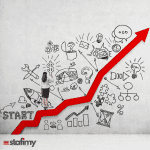The term “career” finds its roots in the French word “carriere.” It encompasses a range of pursuits and endeavors that an individual engages in over the course of their professional journey (Hoekstra, 2011). Put simply, a career represents the culmination of experiences, activities, and the development of professional attitudes and behaviors that an individual accumulates throughout their lifetime (Lewis et al., 1995).
Career management in organizations involves the design and implementation of a process that enables the planning and management of careers in a way that meets the needs of both the organizations and individuals’ preferences and capacities. In other words, career management is also expressed as the support provided by the organization to help individuals achieve their career plans. The concept of career began to be considered as a whole only in the 1970s, and despite systematic research in this field starting after that period, there are still shortcomings in establishing a comprehensive framework for career theory (Baruch & Maury, 2000).
There are multiple interpretations of the term “career.” It can be described as the ongoing developmental processes of individuals, aligning with the work they engage in and the experiences they accumulate within the same or different organizations (Baruch, 2006). Another perspective defines career as the overall advancement individuals achieve throughout their entire professional life (Baruch, 2006).
In broader terms, career encompasses the gradual and continuous progression, accumulation of experiences, and skill development of individuals in any field of work over the duration of their employability. The Turkish Language Association (TDK) defines career as the stage of achievement, success, and expertise individuals attain in a specific profession through dedication and the passage of time.
Human life is a concept that evolves and progresses with the concept of career. In this respect, life and career constitute an inseparable whole. Individuals’ life processes develop in parallel with career stages. The shaping, determination, and development of a career are influenced by various characteristics of the individual, such as physical, sociological, gender, and educational factors.
Table 1 Career Stages and Their Characteristics
| Needs | Security | Success, Respect Autonomy | Success Self-esteem | Self-Fulfillment |
| AGE | 25-30 | 30-45 | 45-65 | 65 |
| CAREER STAGE |
Career Beginning |
Mid-Career |
Career End | Decline (Retirement) |
| Includes the processes of finding the first job, settling into a job, acquiring skills, learning the job, and being accepted by peers. | In this stage, individuals focus on maintaining their existing achievements, they can continue to improve their performance or may no longer achieve new gains. | In this stage, individuals focus on self-orientation, their orientation towards the organization is reduced. | As retirement approaches, an individual’s power, responsibilities, and career decrease. |
Source: Balta, 2007: 18-22
ORGANIZATIONAL CAREER MANAGEMENT
The concept of career and its management largely require individual responsibility, but with the involvement of organizations in this process, the concept of Organizational Career Management (OCM) emerges (Deniz, 2007).
Organizational Career Management (OCM) refers to the programs or activities provided by organizations to support employees’ career success. OCM involves organizational practices in career development. OCM practices have an impact on employees’ job satisfaction. Additionally, OCM practices can increase employees’ organizational commitment. OCM is also associated with job involvement. Job involvement reflects the extent to which individuals psychologically identify with their work, and high levels of job involvement have a significant impact on employees’ performance. Employees who are highly involved in their work put a lot of effort into achieving organizational goals (Wesarat et al., 2014).
The primary goal of organizational career management is to enhance organizational productivity directly, while also facilitating the development of employees within the organization, planning and shaping the qualified workforce that the organization will need (Taşçıoğlu, 2006).
Career management, which involves assisting organizations in analyzing employees’ skills, interests, and preferences, aligning them with organizational interests and goals, and conducting career development activities in this context, consists of two components: “career planning” and “career development.”
1. CAREER PLANNING
Career planning is a part of organizational career management. It involves the management of an individual’s career through education, training, and work experiences (Deniz, 2007).
From an organizational perspective, career planning is an important tool for companies to ensure that employees have the necessary knowledge and skills when needed. Career planning helps align organizational goals with individual goals (Wesarat et al., 2014). In this context, assessments, planned training activities, and the process of selecting, developing, and assigning employees through professional tasks are involved (Deniz, 2007).
Furthermore, career planning practices are significant for many organizations to adapt to environmental changes and sustain their profitability and competitiveness through organizational strategies such as restructuring and downsizing.
Career planning can be divided into two components: individual career planning and organizational career planning.
Individual career planning is a continuous process in which an individual evaluates their own abilities and interests, explores career opportunities, sets career goals, identifies tools to achieve those goals, and identifies appropriate developmental paths. It is continuous because individuals need to periodically review their career expectations due to changes in the environment, organization, and employees.
Individual career planning is influenced by internal factors such as personality, thoughts, achievements, psychological strength, as well as external factors such as social background, family, environment, education, and socio-economic factors. Another factor that influences individual career planning is career patterns.
Career patterns refer to individuals’ behaviors regarding their jobs and careers throughout their professional lives. Since individuals have different skills, interests, and expectations, career patterns also show corresponding differences. Stable career pattern refers to a career development in which an individual continues in the same career after joining the workforce following graduation. Linear career pattern is a career development where an individual progresses in consecutive jobs within the organizational hierarchy, requiring more responsibilities, knowledge, and skills. Individuals with a spiral career pattern tend to work in different fields that are not significantly different from each other. Individuals with a transitional career pattern frequently change jobs from one to another (Balta, 2007).
Organizational career planning, on the other hand, is a continuous process in which organizations assist employees in their self-development or achieving career goals, create development opportunities for them, and establish paths and activities. Organizational career planning focuses on organizational goals and needs. It also continuously offers employees the chance to progress in their career paths.
When viewed as a system, career planning involves both the individual and the organization participating in the system (Doğan, 1996). Career plans provide management with the opportunity to find qualified personnel within the organization while offering individuals the chance to find roles that align with their talents and expectations. In the organizational career approach, integrating individual career goals and orientations with organizational goals is essential. In this context, employees are adequately prepared for future higher positions as long as this alignment is achieved (Deniz, 2007).
2. CAREER DEVELOPMENT
The foundations of the career development concept were first laid by John Dewey, who claimed that effective learning could only occur when it is applied in real life, leading to critical thinking, problem-solving, experiential learning, and the allure of lifelong learning (Webb et al., 2014).
Career development is defined as the planning of an individual’s career through education, training programs, and work experiences, and the effective management of these plans by the organization (Arar & Öneren, 2018). While forming the basis for individual career success, career development also ensures sustainability within both the organization and the industry (Arar & Öneren, 2018).
Table 2 demonstrates how the implementation of human resource tools and practices targeted at career development differs from traditional human resource practices by also including individual career goals and success.
Table 2: Traditional Career and Career Development Approach
| Human Resource Activities | Traditional HR Approach | HRD (Career Development) Approach |
| Human Resource Planning | Analyzes job, skills, and tasks; utilizes statistical data | Also utilizes data on individual interests and preferences |
Recruitment and Placement | Satisfies the needs of the organization and qualified employees | Matches individuals to jobs based on career interests and abilities |
| Training and Development | Provides opportunities to enhance learning skills | Provides career path information and development plans |
| Performance Evaluation | Grades and/or rewards | Development plans and individual goal setting |
| Wage and Incentives | Offers rewards for time, productivity, and talent | Includes training feedback plans and non-job-related payments |
Source: Dessler, 2008: 379
The Traditional Career Approach reflects the view that careers are tied to specific professions in which individuals typically enter at the beginning of their careers or are tied to a single organization that manages them. It is traditionally associated with higher organizational commitment and a relational psychological contract. This approach has been shaped by the societal and organizational structures of both the industrial and post-industrial eras. The traditional career perspective emphasizes stability, hierarchy, clear job definitions, and progression tied to length of service. In the traditional career understanding, career success is expressed through upward movement and external indicators of success (such as salary and social status). The static nature of the organizational structure ensures linear career paths.
SHIFTING PARADIGMS IN CAREER APPROACHES
As a result of the highly competitive global work environment today, employees experience more job loss, find fewer opportunities for vertical mobility within their current employers, and inter-organizational mobility becomes more extensive. Developments in information technology increase the portability of work and lead to an increasing number of employees being electronically connected to their organizations. On the other hand, employees responsible for parents, women, dual-income partners, single parents, and aging parents represent a significant portion of the workforce and likely express a desire to balance their jobs with other aspects of their lives. Additionally, many older workers continue to stay in the workforce beyond traditional retirement age.
As a result of all these developments, the concepts of career and career management are being redefined according to the conditions of the job market, and the focus in career management is shifting from organizations to individuals. Individuals seek opportunities to work with organizations that provide employment types based more on flexibility rather than organizational commitment. At this point, individuals’ perspectives on career management define new career approaches such as Portfolio Careers and Boundaryless Careers. Table 3 demonstrates how the Boundaryless Career approach differs from the traditional career approach in various factors.
Tablo 3 Comparison of Traditional Career and Boundaryless Career
| Factors | Traditional Career | Boundaryless Career |
| Employment/Psychological Contract | Job Security Based on Organizational Commitment | Performance and Flexibility Based |
| Number of Organizations to Work for | 1-2 | 4-6 |
| Skillls | Stable | Dynamic, Open to Development |
| Criteria for Success | Pay, Position, Promotion | Psychological Satisfaction |
| Level of Responsibility in Career Management | Organisation | Individual |
| Orientation Form | Orientation Across the Entire Organization | Job-Focused |
| Key Feature | Age-Focused | Learning-Focused |
Source: Sullivan, 1999: 458
Along with Hall’s “Protean (Portfolio) Career” introduced to the literature in 1996, the concept of career has become more flexible and is now directed by individuals rather than organizations (Arar & Öneren, 2018). Individuals with portfolio career attitudes intend to use their own values (e.g., against corporate values) to direct their careers (“value-driven”) and take an independent role in managing their professional behaviors (“self-directed”) (Segers et al., 2008).
Today’s careers are mostly referred to as “Boundaryless Careers.” Individuals with this type of career tend to identify more with a job or profession than with an employer. It is unlikely for most employees to stay with a single company throughout their entire career or a significant portion of their career (Segers et al., 2008). Portfolio careers are characterized by “individual career management,” and individuals with such careers achieve career success by using their professional behaviors based on their beliefs. On the other hand, boundaryless careers are exemplified by individuals transitioning from one organization to another (Segers et al., 2008).
REFERENCES
- Arar, T., & Öneren, M. (2018). Role of Talent Management in Career Development of Generation Z: A Case Study of a Telecommunication Firm. International Academic Journal of Social Sciences, 5(1). https://doi.org/10.9756/IAJSS/V5I1/1810004
- Balta, E. A. (2007). Career management in organizations, career planning, career development, and coaching practices as a career development program. (Unpublished master’s thesis). Pamukkale University, Institute of Social Sciences.
- Baruch, Y. (2006). Career development in organizations and beyond: Balancing traditional and contemporary viewpoints. Human Resource Management, 45(3), 321-334.
- Baruch, Y., & Maury, P. W. (2000). Career management practices: An empirical survey and implications. Human Resource Management, 39(4), 347-366.
- Davis, P. J. (2015). Implementing an Employee Career-Development Strategy: How to Build Commitment and Retain Employees. Human Resource Management, 23(4), 28-32.
- Dessler, G. (2008). Human Resource Management. Pearson Prentice Hall.
- Deniz, M. (2007). Organizational Career Management as a Function of Human Resources and an Application. Social Sciences, 2(2), 101-119. Retrieved from https://dergipark.org.tr/tr/pub/nwsasocial/issue/20115/213732
- Doğan, S. (1996). Transition model to a flexible career workforce in human resource management. M.Ü., İİBF Dergisi, 12(1-2), 161-178.
- Hoekstra, H. A. (2011). A Career Roles Model of Career Development. Journal of Vocational Behavior, 78(2), 159-173.
- Lewis, P. S., Goodman, S. H., & Fandt, P. M. (1995). Management: Challenges in the 21st Century. West Publishing.
- Segers, J., Inceoglu, I., Vloeberghs, D., Bartram, D., & Henderickx, E. (2008). Protean and boundaryless careers: A study on potential motivators. Journal of Vocational Behavior, 73(2), 212-230.
- Sullivan, S. E. (1999). The Changing Nature of Careers: A Review and Research Agenda. Journal of Management, 25(3), 457-484.
- Taçıoğlu, C. (2006). Effects of Career Management Practices in the Education Sector on Organizational Performance: ‘Theory and Research’. (Master’s thesis). Selçuk University, Institute of Social Sciences.
- Webb, K., Repetto, J., Blackmore, J. S., Patterson, K. B., & Alderfer, K. (2014). Career Development: Preparation, Integration, and Collaboration. Journal of Vocational Rehabilitation, 40, 231-238.
- Wesarat, P., Phathara-On, S., Sharif, M., & Majid, A. (2014). A Review of Organizational and Individual Career Management: A Dual Perspective. International Journal of Human Resource Studies, 4(1), 101. https://doi.org/10.5296/ijhrs.v4i1.5331







